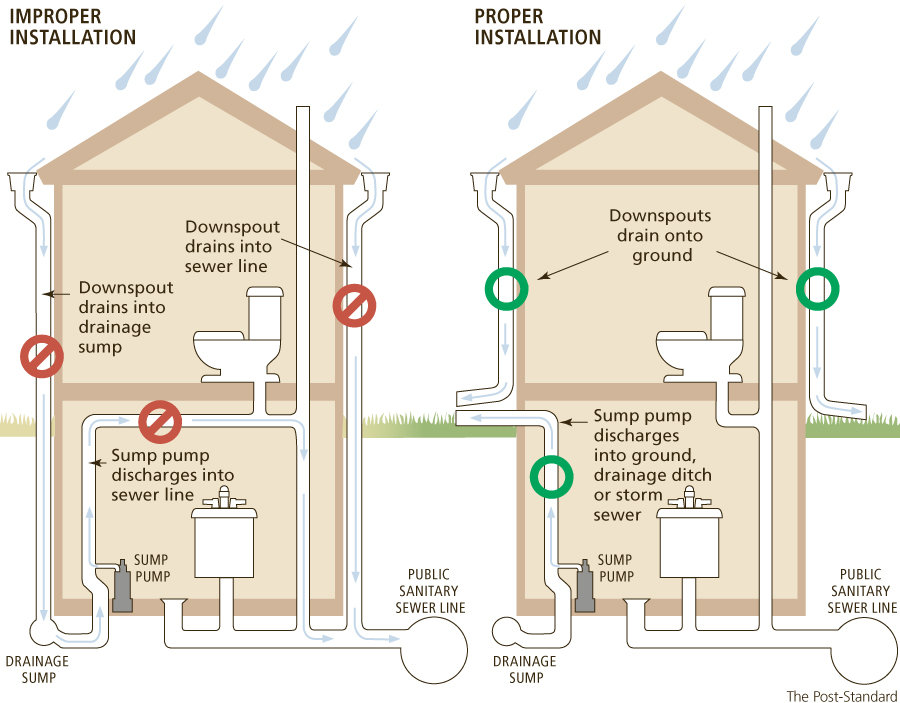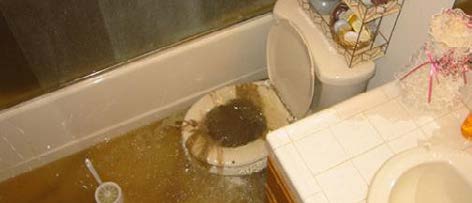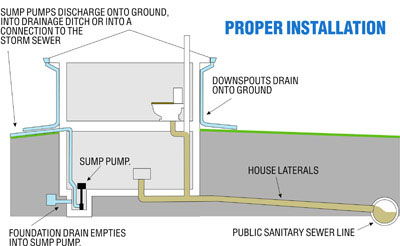Clean Water
Inflow and Infiltration (I & I)

Sources of I & I. Surface runoff from rainfall and snowmelt naturally flows to local streams. A portion of runoff infiltrates into the ground. That groundwater naturally recharges aquifers by percolating down thru soil and subsurface sediment. In urban environments, however, those natural pathways are interrupted and water may accumulate in building basements, crawl spaces and under and around foundations. To avoid structural water damage, that water must be removed. Stormwater collection systems are designed to accept that clean water. Sanitary sewer systems are not. Sanitary sewer systems are designed to collect wastewater (not clean water) for treatment and then safe release back into the environment.
What is Inflow and Infiltration (I & I)?
- Inflow and infiltration (I & I) are terms for the ways that runoff (from rainfall and snowmelt) and groundwater enter into sanitary sewer pipes. Runoff and groundwater are also referred to as clean water (or sometimes as clear water).
- I & I is the component of sanitary sewer flow that originates from clean water. It is water that is removed from the natural hydrologic cycle that normally does not require treatment and should be directed to a stormwater collection system and/or allowed to travel a natural path to a stream or into the groundwater system (the graphic above shows I & I sources).
- Inflow is clean water that enters the wastewater system through sump pumps, rain leaders, storm sewer cross connections, and foundation drains that are connected to sanitary sewer pipes. Inflow is greatest during major storm events and spring snowmelt. Wastewater volumes can triple during those times.
- Infiltration is a more gradual process, and occurs when clean water seeps into sanitary sewer pipes through cracks, leaky pipe joints and/or deteriorated manholes.
Why Inflow and Infiltration (I & I) Matters?

- I & I reduces pipe space to carry wastewater. Too much I & I in sewer pipes can cause overflow of untreated wastewater and/or backups to your, or your neighbor’s, home that you could be liable for. Insurance does not always cover sewage backups. Untreated wastewater released into the environment or a building impacts our environment and public health.
- I & I is clean water that does not require expensive wastewater treatment. Excessive I & I unnecessarily increases treatment costs and may result in customer price increases for sanitary sewer service.
- I & I reduces pipe capacity that was built, and paid for with impact fees, to accommodate existing and new customers.
- Clean water runoff and groundwater that is entering sanitary sewer pipes is removed from the natural hydrologic cycle and does not flow into our local streams and ground to recharge aquifers.
What You Can do to Reduce I & I on Your Property?

- Check your sump pump connection. Have your plumber disconnect it from the sewer system. We can help (see below). National statistics show that a sump pump can pump up to 7,200 gallons per day of clean water into the wastewater system. That’s the equivalent of an average sized residential swimming pool. SBWRD collects and treats a daily annual average of 4.0 million gallons of wastewater per day. If 100, of the 13,000 customer accounts that SBWRD serves (less than 1% of customer base), each pumped 7,200 gallons per day, that would represent 18% of SBWRD wastewater flow. A disproportionate share that all customers pay for.
- Have your sewer service line (lateral) that connects from your home to the public sewer system inspected and repaired by a qualified plumber if there is damage.
- Inspect your gutters/downspouts and “yard” drains to make sure that they are not connected to the sewer system.
We Can Help!
- Currently, SBWRD is offering up to $1,500 of financial assistance to residential homeowners who will disconnect their sump pump from the sewer system. This assistance is only available for a limited time.
- SBWRD will send knowledgeable staff to assist homeowners in discovering if there are sump pumps, or other drains, connected to the sewer system. There is no cost to the homeowner.
- We want to help! Call us at 435-649-7993 and ask for help with reducing I & I on your property.
